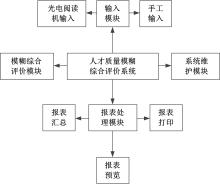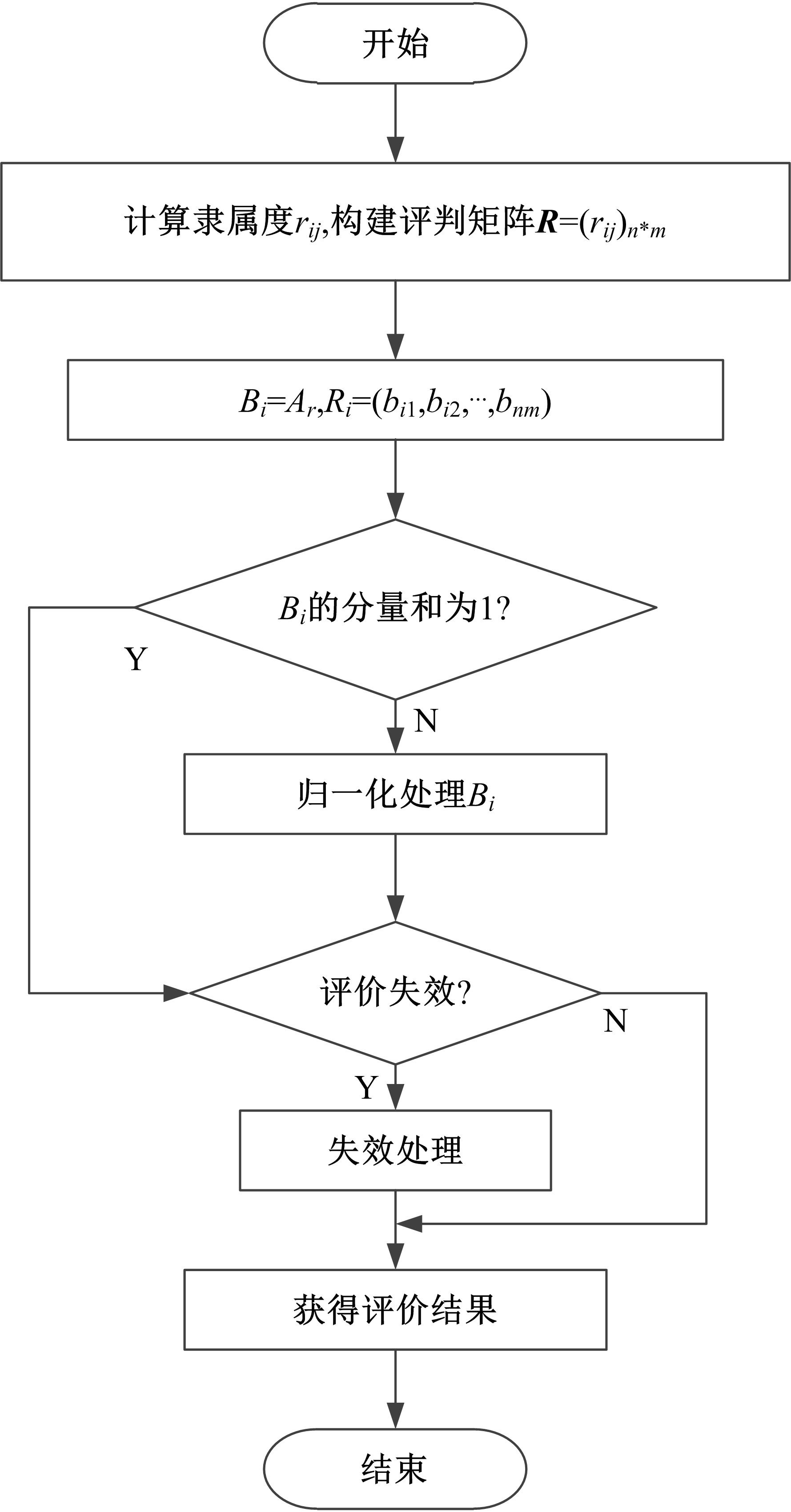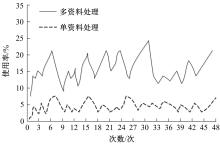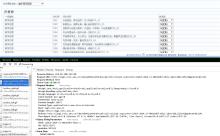Journal of Jilin University(Engineering and Technology Edition) ›› 2020, Vol. 50 ›› Issue (5): 1856-1861.doi: 10.13229/j.cnki.jdxbgxb20190923
Design of fuzzy comprehensive evaluation system for talent quality based on multi⁃objective evolutionary algorithm
- 1.Office of Talent Work,Jilin University,Changchun 130011, China
2.College of Computer Science and Technology, Jilin University,Changchun 130011, China
CLC Number:
- TP18
| 1 | 赵馨蕊, 周雨青. 基于模糊综合评价法的大学物理MOOC教学质量评价[J]. 高等工程教育研究, 2019(1): 190-195. |
| Zhao Xin-rui, Zhou Yu-qing. MOOC teaching quality evaluation of college physics based on fuzzy comprehensive evaluation method[J]. Research in Higher Education of Engineering, 2019(1): 190-195. | |
| 2 | 陆晓芳, 王川, 赵树宽. 人才要素区域竞争力评价模型[J]. 吉林大学学报: 工学版, 2003, 33(3): 82-85. |
| Lu Xiao-fang, Wang Chuan, Zhao Shu-kuan. Evaluation model of regional competition ability of talents[J]. Journal of Jilin University(Engineering and Technology Edition), 2003, 33(3): 82-85. | |
| 3 | 梁承姬, 姚远, 徐德洪, 等. 基于模糊综合评价法的北极挂靠港建模选择研究[J]. 华中师范大学学报: 自然科学版, 2017, 51(6): 817-824. |
| Liang Cheng-ji, Yao Yuan, Xu De-hong, et al. Study on the selecting model for Arctic ports of call basing on fuzzy comprehensive evaluation method[J]. Journal of Huazhong Normal University(Natural Sciences), 2017, 51(6): 817-824. | |
| 4 | 包甜甜, 王岩磊, 李猛, 等. 基于证据推理的多指标评价系统设计与实现[J]. 计算机工程与科学, 2016, 38(6): 1269-1274. |
| Bao Tian-tian, Wang Yan-lei, Li Meng, et al. Design and implementation of a multiple attribute evaluation system based on evidence reasoning[J]. Computer Engineering and Science, 2016, 38(6): 1269-1274. | |
| 5 | 张立昆, 季叶克. 科技查新质量三维评价体系研究[J]. 情报杂志, 2016, 35(4): 160-163, 97. |
| Zhang Li-kun, Ji Ye-ke. A study on three-dimensional system of novelty retrieval evaluation model[J]. Journal of Intelligence, 2016, 35(4): 160-163, 97. | |
| 6 | 任宏, 杜永杰, 陈永奇, 等. 距离测度视角下生态城市规划方案三维评价模型研究[J]. 科技进步与对策, 2016, 33(16): 81-85. |
| Ren Hong, Du Yong-jie, Chen Yong-qi, et al. Study on the 3D evaluation model of eco-city planning under the distance measure perpective[J]. Science & Technology Progress and Policy, 2016, 33(16): 81-85. | |
| 7 | 刘清华, 郑惠珍. 基于模糊综合评价法的高校人才柔性流动效果评价研究[J]. 潍坊工程职业学院学报, 2019(6): 41-47. |
| Liu Qing-hua, Zheng Hui-zhen. Research on the effect evaluation of flexible flow of talents in colleges and universities based on fuzzy comprehensive evaluation method[J]. Journal of Weifang Engineering Vocational College, 2019(6): 41-47. | |
| 8 | 徐勇, 张慧, 陈亮. 一种基于情感分析的UGC模糊综合评价方法——以淘宝商品文本评论UGC为例[J]. 情报理论与实践, 2016, 39(6): 64-69. |
| Xu Yong, Zhang Hui, Chen Liang. A UGC fuzzy comprehensive evaluation method based on sentiment analysis——taking UGC of Taobao product text reviews[J]. Information Studies:Theory & Application, 2016, 39(6): 64-69. | |
| 9 | 方春明, 孔繁森, 隽志才. 基于模糊综合评判与灰色关联分析的汽车工业第三方物流服务商评价指标体系[J]. 吉林大学学报: 工学版, 2009, 39(): 133-137. |
| Fang Chun-ming, Kong Fan-sen, Zhi-cai Juan. Evaluation index system on 3PL in automotive industry based on fuzzy comprehensive evaluation and grey correlation analysis[J]. Journal of Jilin University(Engineering and Technology Edition), 2009, 39(Sup.1): 133-137. | |
| 10 | 刘焕军, 李石君. 应用模糊综合评价进行智能手机评估建模[J]. 计算机工程与应用, 2016, 52(1): 224-228. |
| Liu Huan-jun, Li Shi-jun. Apply fuzzy comprehensive evaluation to establish smartphone assessment model[J]. Computer Engineering and Applications, 2016, 52(1): 224-228. |
| [1] | Bing-hai ZHOU,Zhao-xu HE. Dynamic material handling scheduling for mixed⁃model assembly lines based on line⁃integrated supermarkets [J]. Journal of Jilin University(Engineering and Technology Edition), 2020, 50(5): 1809-1817. |
| [2] | Hong-wei ZHAO,Xiao-han LIU,Yuan ZHANG,Li-li FAN,Man-li LONG,Xue-bai ZANG. Clothing classification algorithm based on landmark attention and channel attention [J]. Journal of Jilin University(Engineering and Technology Edition), 2020, 50(5): 1765-1770. |
| [3] | Nai-yan GUAN,Juan-li GUO. Component awareness adaptive model based on attitude estimation algorithms [J]. Journal of Jilin University(Engineering and Technology Edition), 2020, 50(5): 1850-1855. |
| [4] | Xiang-jiu CHE,You-zheng DONG. Improved image recognition algorithm based on multi⁃scale information fusion [J]. Journal of Jilin University(Engineering and Technology Edition), 2020, 50(5): 1747-1754. |
| [5] | Zhou-zhou LIU,Wen-xiao YIN,Qian-yun ZHANG,Han PENG. Sensor cloud intrusion detection based on discrete optimization algorithm and machine learning [J]. Journal of Jilin University(Engineering and Technology Edition), 2020, 50(2): 692-702. |
| [6] | Yin-ping LI,Tian-xu JIN,Li LIU. Design and dynamic characteristic simulation of pantograph⁃catenary continuous energy system for pure electric LHD [J]. Journal of Jilin University(Engineering and Technology Edition), 2020, 50(2): 454-463. |
| [7] | Shun-fu JIN,Xiu-chen QIE,Hai-xing WU,Zhan-qiang HUO. Clustered virtual machine allocation strategy in cloud computing based on new type of sleep-mode and performance optimization [J]. Journal of Jilin University(Engineering and Technology Edition), 2020, 50(1): 237-246. |
| [8] | Man CHEN,Yong ZHONG,Zhen-dong LI. Multi-focus image fusion based on latent low⁃rank representation combining low⁃rank representation [J]. Journal of Jilin University(Engineering and Technology Edition), 2020, 50(1): 297-305. |
| [9] | Xiao-hui WANG,Lu-shen WU,Hua-wei CHEN. Denoising of scattered point cloud data based on normal vector distance classification [J]. Journal of Jilin University(Engineering and Technology Edition), 2020, 50(1): 278-288. |
| [10] | Xiao-dong ZHANG,Xiao-jun XIA,Hai-feng LYU,Xu-chao GONG,Meng-jia LIAN. Dynamic load balancing of physiological data flow in big data network parallel computing environment [J]. Journal of Jilin University(Engineering and Technology Edition), 2020, 50(1): 247-254. |
| [11] | Jun-yi DENG,Yan-heng LIU,Shi FENG,Rong-cun ZHAO,Jian WANG. GSPN⁃based model to evaluate the performance and securi tytradeoff in Ad-hoc network [J]. Journal of Jilin University(Engineering and Technology Edition), 2020, 50(1): 255-261. |
| [12] | Tie-jun WANG,Wei-lan WANG. Thangka image annotation based on ontology [J]. Journal of Jilin University(Engineering and Technology Edition), 2020, 50(1): 289-296. |
| [13] | Xiong-fei LI,Jing WANG,Xiao-li ZHANG,Tie-hu FAN. Multi-focus image fusion based on support vector machines and window gradient [J]. Journal of Jilin University(Engineering and Technology Edition), 2020, 50(1): 227-236. |
| [14] | Hong-yan WANG,He-lei QIU,Jia ZHENG,Bing-nan PEI. Visual tracking method based on low⁃rank sparse representation under illumination change [J]. Journal of Jilin University(Engineering and Technology Edition), 2020, 50(1): 268-277. |
| [15] | Bing-hai ZHOU,Qiong WU. Balancing and optimization of robotic assemble lines withtool and space constraint [J]. Journal of Jilin University(Engineering and Technology Edition), 2019, 49(6): 2069-2075. |
|
||








